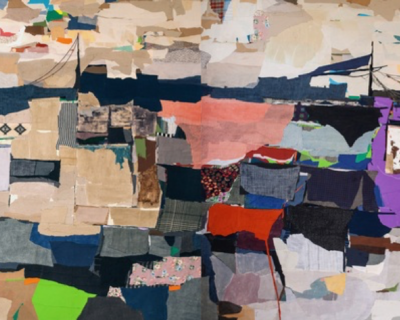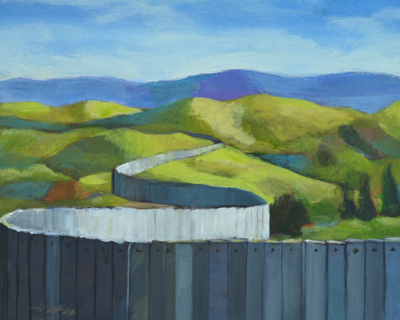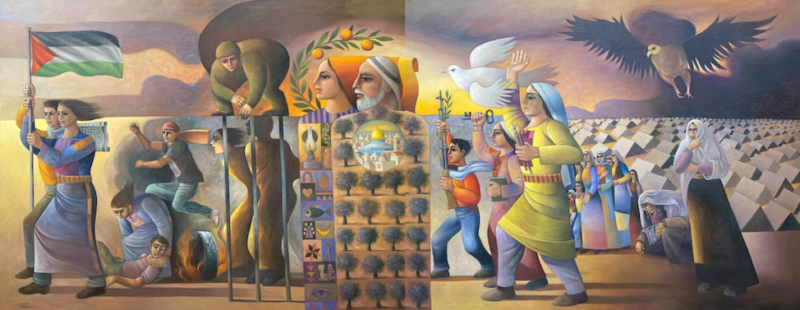Visual Art as Politico-Cultural Affirmation in Palestine: Identity, Trauma, and Optimism
Megan Oleksiw
Protest and Propaganda, World Views, 345-102-MQ
Note: hover mouse over images to see figure numbers and descriptions

Inhabiting the segregated margins of a state which denies their statehood, the Palestinian people grapple with the fragmentation, denial, and persistent repression of their identity and territorial independence. Since its foundation in 1948 – and notably in the aftermath of 1967’s Six-Day War – the state of Israel has pursued the colonization of Palestinian lands, which are now referred to as being under Occupation, and implemented apartheid policies limiting the opportunities and welfare of its non-Israeli citizens. Indeed, the majority of Palestinians are now confined to the Gaza strip and cities pockmarking the West Bank, and often hold neither an official property deed nor state-recognized citizenship. These occupied areas, heavily militarized, impoverished, and zoned-off by walls, make up a fragmented Palestine – one whose political agency is frail and whose citizens struggle to situate themselves within the social fibre of the Israeli state. In this respect, Palestinian Nationalism describes both the will of the Palestinian people for self-determination (in the currently occupied West Bank, East Jerusalem and Gaza) and their strive to resist the cleansing of their culture. This essay will examine the use of contemporary fine art in Palestine as a means of politico-cultural affirmation against occupation, both through imagery commemorative of identity and trauma as well as nationalistically hopeful depictions, and in doing so, will analyze the works of Sliman Mansour and Khaled Hourani against their troubling social backdrop. Given that the Palestinian nationalist movement encompasses a wide array of subset ideologies, ranging from pacifism to radical Islamism, and consequently inspires diverse art forms, this essay will limit its scope to non-radical Palestinian Nationalism as explored in by established local artists.

Palestinian Nationalism: An Opposition to Occupation
The history of Palestine is one plagued by geopolitical instability and interracial conflict. Bounded by the Jordan River and the Mediterranean Sea, the disputed region is at the crossroads of opposing interests, notably due to Palestine’s religious significance as both the birthplace of Judaism and Christianity as well as Islam’s ‘Holy Land’. Although the region was predominantly Muslim under Ottoman rule, the emergence of Zionism in the late nineteenth century shifted its demographic composition. Zionism is defined as the “Jewish nationalistic movement that has had as its goal the creation and support of a Jewish national state in Palestine, the ancient homeland” (Britannica). This movement idealized ‘the ingathering of exiles’ (biblical term) in the Jewish heartland, referred to as kibbutz galuyot, and advocated for the foundation of Israel. This vision was endorsed by Britain throughout its administrative rule over the region during Mandatory Palestine (from 1922 and until 1948) and later officialised by the United Nations General Assembly’s Partition Plan, which devised the separation of Palestine into two autonomous states.
However, following the termination of the British Mandate in 1948, a civil war gripped the region and resulted in the forced exodus of 80% of Palestinians and destruction of 400-600 villages in an ethnic cleansing campaign which became known as the Nakba (“catastrophe”). Over the course of the following decades, Israel tightened its grip on the region and conquered in 1967 the two remaining parts of Palestine under Arab (respectively, Egyptian and Jordanian) control: the Gaza Strip and the West Bank. Although peace accords established an interim self-government body, the Palestinian National Authority (PA) – which now co-governs with Hamas, a fundamentalist, militant party – social unrest and military exchanges still relentlessly trouble the region. Thus far, two Intifadas (sustained periods of Palestinian protests and riots) challenged the status quo in the occupation of the West Bank and Gaza as well as the upholding of apartheid policies (segregated ID cards, limited displacement within the country, etc.). Occupation describes “lands acquired by force and where Israel maintains effective control through the Military Government of Israel” (OHCHR annex 2). Currently, tension in the region has flared up again and surfaced to international attention ensuing eviction orders in the East Jerusalem neighborhood of Sheikh Jarrah and a steep escalation into heavy military conflict between Hamas and Israeli forces.
Palestinian Nationalism presents itself as the movement advocating the liberation of the Palestinian people from Israeli Occupation and the safeguarding of their culture. Non-militant Palestinian Nationalists view themselves as rightful citizens of the West Bank, Gaza, and East Jerusalem territories. Though some are partisans of a two-state solution in which Palestine be recognized as a sovereign state, many advocate for a one-state solution in which both Palestinians and Israelis equitably cohabit as a multicultural state (commonly referred to as the ‘Lebanese model’). The guiding belief of the movement is that Palestinians have the right to live as free and recognized citizens of their ancestral territories. Hence, the artistic expressions of the movement often focalize on the reclaiming of spatiality (taking ownership of Palestinian landscapes and cities) and a reappropriation of the national narrative (putting forth Palestinian families and the Nakba). The aesthetics of the movement are occasionally referred to as the Liberation Art Movement, or briefly during the First Intifada, as the New Visions group. As briefly discussed in the introduction, this essay aims to analyze the means by which a counternarrative emerges in the visual culture of the Palestinian worldview; one which not only opposes the hegemonic occupation of lands but also sensitively captures the wounds and aspirations of Palestinians past and present.

Visual Material: Identity and Occupation
Visual Media within the Palestinian Nationalistic movement comprises a wide range of forms and content reflecting the diversity within the movement. Undeniably, a radicalized subset of this visual media is heavily militant and serves as fundamentalist propaganda meant to promote extremist anti-Zionist action. These visual campaigns are often sponsored by broader Islamist terrorist groups (Jihad) and employ posters, graffiti and digital media as a subversive recruitment apparatus which celebrates the extremist ‘exploits’ of Shahids (martyrs) and disseminates extremist interpretations of the Quran.
However, the focus of this essay – the non-militant subset of the Palestinian Nationalist movement – is concerned less with a grand ideological opposition to Zionism or direct military action, but rather with the affirmation of the Palestinian identity and the communication of their reality to the international community. Contemporary Palestinian artists advocating for the sovereignty of their homeland and the recognition of their people’s wounds and aspirations often engage in street art, photography, painting, and sculpture. Whereas street art domestically attempts to shape a discourse around Palestine, ‘traditional’ fine art forms such as painting, and sculpture seek to escape the static local situation by targeting an international audience through more formal pathways (exhibitions, awards, etc.). Thus, the core audience of these politicized artworks are foreign viewers. Given the lack of progress within Israel, some artists hope to reach beyond borders and inspire an external uprising against Israeli occupation. Political art enables these local artists to both keep alive the identity of their people as well as push for a saner future: equal rights for Palestinians whether that be within Israel or as an independent state.

Often seen in mixed-media creations, raw and grainy materials such as cement, metal, barbed wire and cloth (fig. 5,8,9) emphasize the precarious living conditions and bleakness of occupied Palestine. They tangibly bear witness to the physical scars of Palestinian land by recalling the imagery of the Separation Wall (delimiting the West Bank), barbed wire fences as well as the imprint of bombardments. Furthermore, they concretize the idea of dispossession: of idyllic landscapes being reappropriated by a colonizing power and reduced to ravaged, inhospitable, and alienating war grounds.

For example, Khaled Hourani’s Unnatural Landscapes series (fig. 7) captures scenic landscapes, lush rolling hills or olive groves, fragmented by a somber cement wall. These depictions of the Separation Wall emphasize its dystopian nature as an intrusive structure, instrumental in the political reworking of natural spaces. In contrast with such portrayals of the current Palestinian landscape, acclaimed artist Sliman Mansour creates idealistic depictions of pre-Mandate Palestine (fig. 3), employing a warm palette to portray women (a symbol of the motherland) in orange groves. This utopian view of a pre-Mandate past conveys a nationalistic longing for one’s homeland. Hence, the present rapport to landscape is dominated by themes of alienation, loss, and longing for an idealized past. In this respect, landscape is oft viewed in the Palestinian art realm as a “deeply layered terrain of inscriptions, memories and histories, which holds a central place in [their] identity” (Sherwell 2).

Also incorporated into most politicized works are the Separation Wall (fig. 1,4,6,7), the Dome of the Rock (fig. 1,2), and olive or orange trees (fig. 1,9) as recurrent motifs emblematic of the Palestinian identity. These motifs transmit a sense of belonging and cultural heritage. At the heart of these works is the communication of a struggle – the limitations and ailments of a people under occupation – as well as the commemoration of their whitewashed history. Themes explored are oft those of everyday hardships. As Mansour puts it: “I reflect in my art the world in which I live. My misfortune is that I live under occupation” (Mansour Interview). Questions of memory, identity, and trauma surface in the abundant representation of families, maternal figures, and refugee camps (notably in Sliman Mansour’s oeuvre). In this respect, Palestinian art “often endeavour[s] to depict their trauma of refugeehood and exile” (Salih and Richter-Devroe 10). Hence, works are deeply rooted in the personal as a rich manifestation of a broader political agenda: they aim to build both local and international pressure on the State of Israel to seize occupation and come to an equitable arrangement with Palestine (whether it be a one-state or two-state solution).

Discussion: Revolution was the Beginning by Sliman Mansour
Refer to figure 1. Often referred to as “the artist of the intifada” for his engagement with political subject matter, Sliman Mansour is a distinguished painter and illustrator living and working in Jerusalem. Likened to a mural, Mansour’s imposing oil painting Revolution was the Beginning spans five meters in length. With a diverse palette and his characteristic Cubist aesthetic, Mansour visually recounts the history of the Palestinian people. Chronologically from right to left, the painting spans from the 1940s to the present day by highlighting historical milestones. To the right extremity, grim colours depict dozens of tents – a refugee camp – stretching out to the horizon under an ominously cloudy sky. Overhead, a large vulture circles as women and children are seen miserably walking towards the left. This quarter of the painting depicts the 1948 Nakba, “catastrophe”, in which eighty percent of the Palestinian population was displaced from their homeland and their villages razed to the ground. As the painting progresses to the center, the palette briefly lightens and inspires hope as women and a man, accompanied by a dove, are seen marching with paintbrushes, books, a key, and a gun. These elements evoking opportunity (books) and freedom (key and dove) symbolize the hope of Palestinians prior to Occupation (1967).

At the core of the piece are a man and woman, stubbornly upright dead-center. They embody Palestinian identity and culture, through the symbols of the Dome of the Rock (mosque) and olive groves that they carry within themselves, as an untouchable baggage which endures regardless their chaotic surroundings. Indeed, the two figures stand as passive pillars, unscathed by the commotion of their surroundings. To their left is a depiction of imprisonment as well as a scene of violence; a woman crying over the body of a boy and a man jumping over a flaming tire. This recalls the Intifadas (“uprisings”) of 1987-1993 and 2000-2005 and, more broadly, the regular occurrence of warfare and terrorism in Palestinian territories. Lastly, to the left edge proudly stands a youthful pair holding up the Palestinian flag and marching onwards in a hopeful stance towards the future.
Unmistakably, this piece is starkly political through its abundant incorporation of symbols of identity (mosque, olive grove, flag), freedom (dove, key), and oppression (vulture, prison, soldier), as well as its depiction of a tumultuous history (Nakba and Intifadas). It aestheticizes the struggle of Palestinian nationals as they strive for liberation by conveying the trauma of displacement alongside the hope of return. Hence, the piece clearly drives forward the political agenda of the Palestinian Nationalistic movement against Occupation. Visually, Israel is evoked pejoratively through the figures of the soldier and the vulture circling over the Nakba scene. These oppressing figures tower above a horizontal line, intended to recall the Separation wall, that confines the Palestinian figures to the bottom half of the plane. Only the Palestinian flag, the dove, and the heads of the ‘identity pillars’ (man and woman carrying cultural symbols) transgress this visual and figurative barrier. This representation celebrates attachment to one’s nation and identity as the only way to resist oppression (embodied by the line) and progress towards a peaceful solution. However, it also captures the frailty of such attempts and the “hopelessness shared by [Mansour] and the community in general faced with an occupation [they] thought would only last a few years” (Mansour Interview). Thus, Revolution was the Beginning acts as a form of protest art, meant to encapsulate the medley of trauma, resilience, and hope in Palestinian communities since the Nakba and criticize the decades-long subjugation of the Palestinian people. It also challenges the hegemonic narrative in Israel in which the ethnic cleansing of the Nakba is brushed over and the Palestinian Nationalistic movement portrayed only as its radical subset (antisemitic Islamist extremism). Indeed, violence (the scene with the flaming tire) does not cross the wall’s barrier whereas the dove (symbol of peace) does. In this manner, the piece discourages militancy and rather focalizes on the Palestinian people’s will for a peaceful solution.
Discussion: Rihan by Khaled Hourani
Refer to figure 6. Born in 1965 in the West Bank city of Hebron, Khaled Hourani is an eminent Palestinian politically engaged artist and curator living in Ramallah. In Rihan, Hourani portrays a barefooted Palestinian boy clothed in military-print capris and a Keffiyeh scarf effortlessly jumping over the Separation Wall. The low angle of the painting emphasizes the grandeur of the boy, who seems to soar through the sky, rather than the height of the wall, which merely lines the bottom of the canvas. This piece is part of a five-painting series depicting smiling youth effectuating similar super-hero-like jumps over the Separation Wall. Youth is symbolically depicted as a strong force, capable of surpassing the barriers that have historically oppressed the Palestinian people. Hence, these works “highlight the hope and optimism Hourani sees in the generation of Palestinian youth” (Zawyeh Gallery 1).

Indeed, this piece aestheticizes the promise of resistance: it implies that the Separation Wall – a symbol of occupation – is in fact surmountable. The revolutionary symbolism of the Keffiyeh scarf worn by Rihan furthers this idea of Palestinian revolutionary will overcoming Israeli tactics of apartheid. In fact, the Keffiyeh dates back to the Ottoman period and established itself as a widespread symbol of Palestinian nationalism during the 1936-1939 Arab Revolt against the British administration of Palestine. The power and promise in the portrayal of children in Hourani’s work also challenges the general attitude surrounding Palestine and its future. Often times, both in Palestinian artwork and international media, focus is placed on the helplessness and trauma of these children rather than on their ability to bring forth change. Thus, as protest art, Rihan constitutes a playful yet symbolic opposition to Occupation and a counternarrative to hopelessness.
Conclusion
Contemporary Art in Palestine effectively critiques Occupation by affirming Palestinian identity through both the commemoration of struggles past and present as well as the communication of hope for a brighter future. Through the works of Mansour and Hourani emerges a resistive voice; one which resiliently draws attention to and challenges the oppression of the Palestinian people. Optimism and trauma intersect to reflect the reality of a people striving for recognition and equal status. As the conflict thunders on in a recent haze of violence, such politically engaged art is notably essential in keeping alive dialogue and communicating Palestine’s will for a peaceful solution.
Works Cited
Corm, Georges. “Thoughts on the Roots of the Arab-Israeli Conflict.” Jorunal of Palestine Studies, vol. 21, no. 3, Spring 1992, pp. 71-79.
Desai, Bindu T. “Palestine Through History.” Economic and Political Weekly, vol. 24, no. 16, April 1989, pp. 869-874.
El Shakry, Hoda. “Palestine and the Aesthetics of the Future Impossible.” Interventions: Journal of Postcolonial Studies, March 2021.
Laïdi-Hanieh, Adila. “Palestinian Visual Art (IV).” Palestinian Journeys, https://www.paljourneys.org/en/timeline/highlight/10593/palestinian-visual-arts-iv. Accessed 18 May 2021.
Manna, Adel. “The Palestinian Nakba and its Continuous Repercussions.” Israel Studies, vol. 18, no. 2, Summer 2013, pp. 86-99.
Mansour, Suleiman. Interview by Stephen Sackur. BBC HardTalk, 03 Sept. 2018, https://www.bbc.co.uk/sounds/play/w3cswj8x.
Office of the United Nations High Commissioner for Human Rights (OHCHR). “Key of Terms pertaining to Israel/Palestine.” OHCHR Annex, 2020, https://www2.ohchr.org/english/bodies/cerd/docs/ngos/jointngo3.pdf.
Salih, Ruba & Richter-Devroe, Sophie. “Cultures of Resistance in Palestine and Beyond: on the Politics of Art, Aesthetics, and Affect.” The Arab Studies Journal, vol. 22, no. 1, Spring 2014, pp. 8-27.
Sherwell, Tina. “Intimate Terrains: Representations of a Disappearing Landscape.” The Palestinian Museum, April 2019 Exhibition. https://www.palmuseum.org/ehxibitions/intimate-terrains-representations-of-a-disappearing-landscape.
Vakil, Iman. “Zawyeh Gallery’s Inaugural Dubai Show Explores Resilience Through Palestinian Art.” Harper’s Bazaar Arabia, Summer 2020 Art issue. https://www.harpersbazaararabia.com/culture/art/zawyeh-gallerys-inaugural-dubai-show-explores-resilience-through-palestinian-art.
Zawyeh Gallery. “Palestinian Art: Resilience and Inspiration.” Zawyeh Gallery Online, March 2020 Exhibition. https://zawyeh.net/palestinian-art-resilience-and-inspiration/.
“Zionism.” Encyclopedia Britannica. https://www.britannica.com/topic/Zionism.



